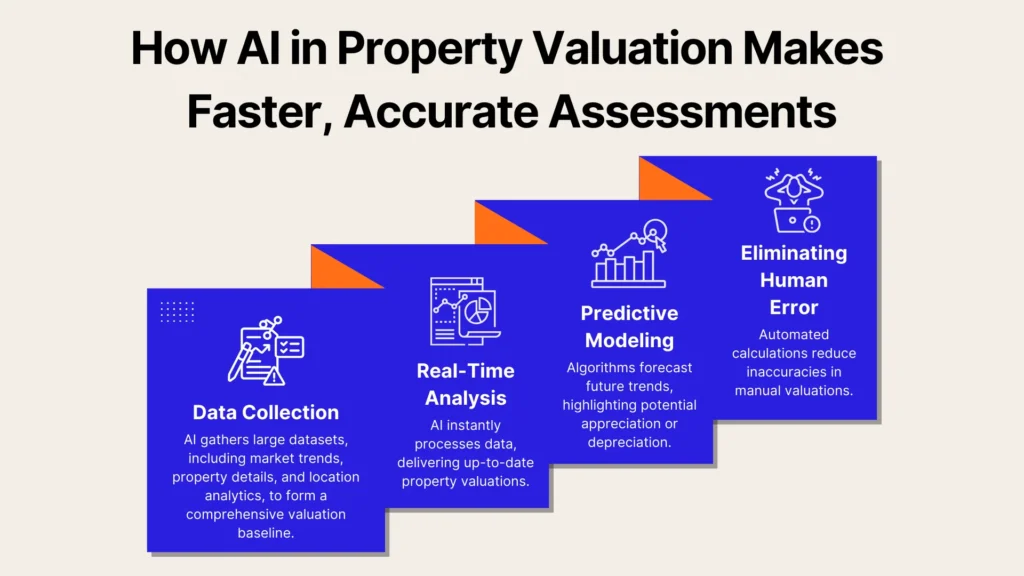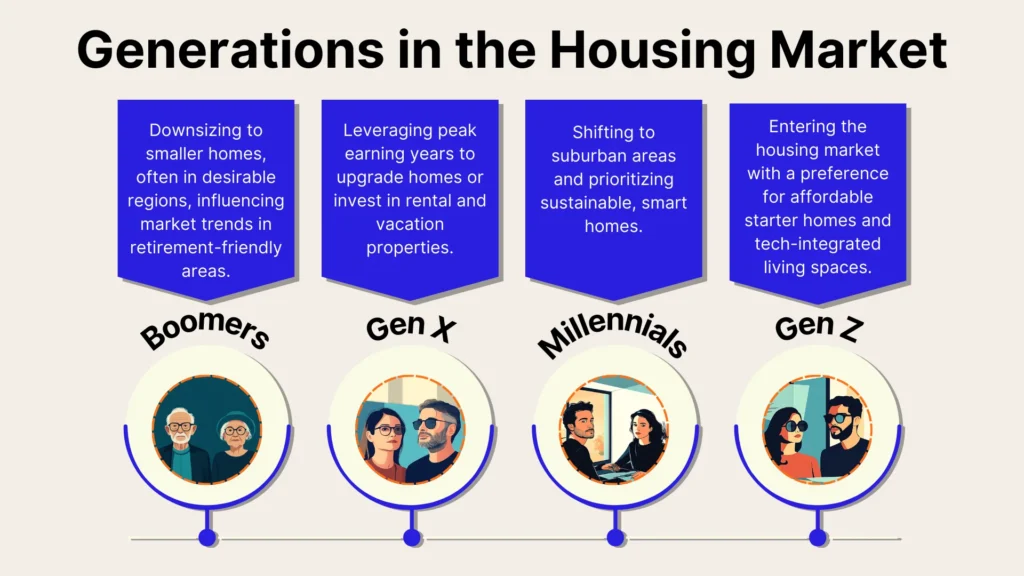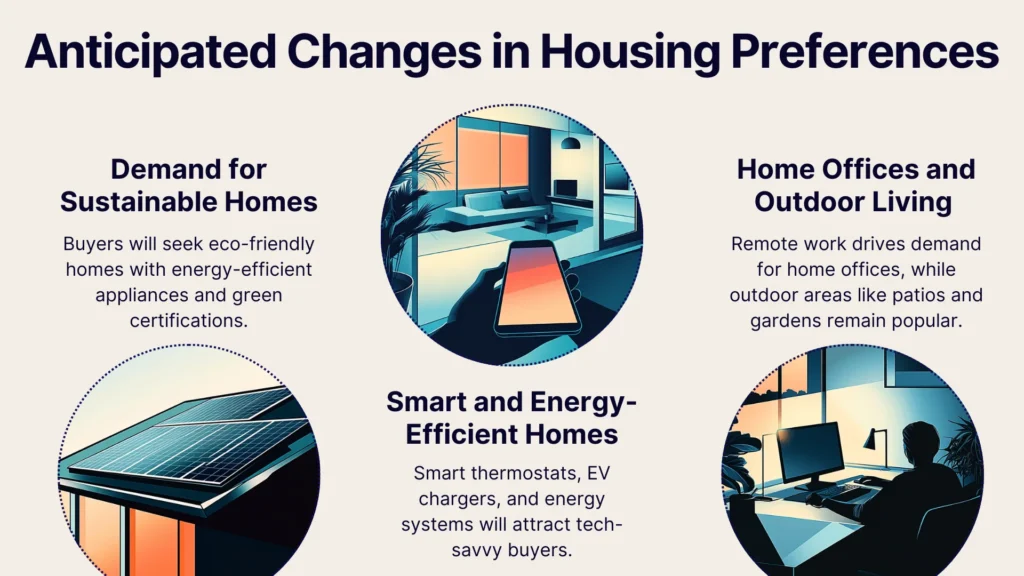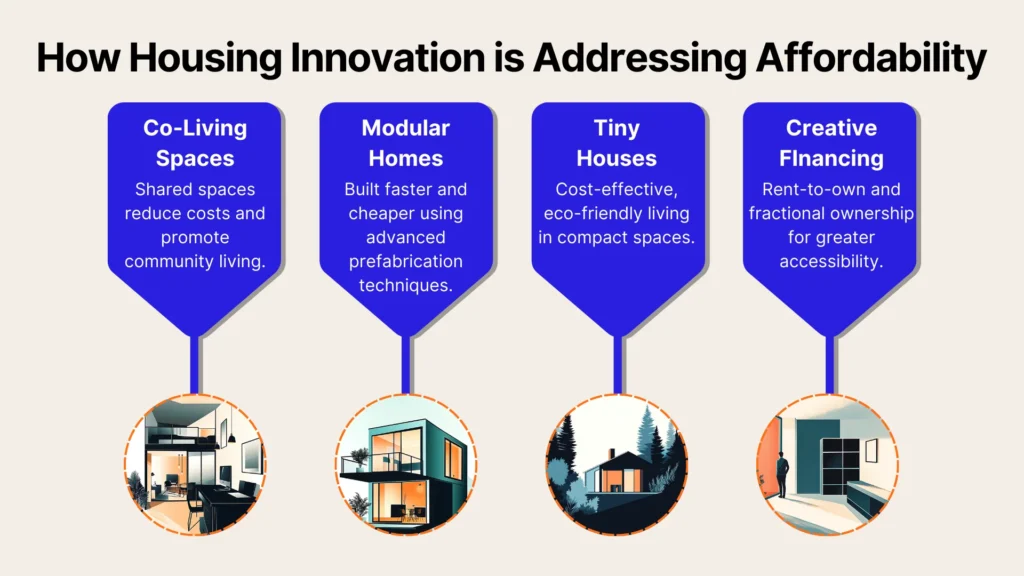The real estate market evolves with societal, technological, and economic shifts. In 2025, buyers, sellers, investors, and industry professionals must understand the anticipated trends. In this article, we’ll explore the major factors shaping residential real estate, focusing on emerging technologies, demographic changes, shifting housing preferences, and economic influences.
What Are The Predicted Real Estate Trends For 2025?
Real estate trends in 2025 reflect broader societal changes and technological advancements. Here are some of the trends that will shape the market in the coming year:
- Sustainability: Homes with eco-friendly features like energy-saving windows and solar panels will be more desirable for buyers prioritizing sustainability.
- Smart home technology: Tech-savvy buyers will be looking for smart home integration in an ideal home.
- Shifts in buyer demographics: More millennials and Gen Z buyers are entering the market, changing buyer preferences and sought-after features.
These changes promise to redefine the residential housing market, influencing how homes are built, sold, and lived in.
How Will Technology Impact Real Estate In 2025?
Technology will be a driving force in reshaping the real estate industry. It will enhance the buying and selling process, making it more efficient and accessible for all stakeholders. Here are a few ways technology will change the market:
Virtual Reality Tours Become Standard For Viewing Homes
Virtual reality (VR) tours will become a standard tool in real estate by 2025. These immersive tours allow potential buyers to explore properties remotely, saving time and providing a realistic sense of the space. VR technology reduces the need for physical visits, making it particularly valuable for out-of-town buyers or those exploring properties in different countries.
Additionally, VR tours can showcase potential renovations or design changes, offering buyers a personalized vision of the property. This accessibility broadens the market’s reach, attracting international investors and remote workers looking for their ideal living spaces. Virtual tours are also becoming more interactive, enabling buyers to change furniture arrangements or explore multiple design options within the same space.
AI In Property Valuation For Faster, Accurate Assessments
Artificial intelligence (AI) is revolutionizing property valuation. Using large dataset analysis, AI can provide precise, real-time valuations, taking into account factors like market trends, location, and property condition. This technology enables faster decision-making for buyers and sellers, reducing the time properties spend on the market.

AI can identify undervalued properties, creating opportunities for investors to maximize returns. AI-powered predictive analytics also help agents and buyers anticipate market trends, enabling informed decisions in volatile markets. AI-driven platforms like Propbox are innovating in the market using these data-driven insights.
Smart Home Technology Integration In New Constructions
New homes in 2025 are predicted to increasingly feature integrated smart home technologies. Builders will prioritize systems that enhance energy efficiency, security, and convenience. These innovations, from voice-controlled lighting to automated climate control, cater to tech-savvy buyers seeking modern, connected living spaces. Interoperability between devices will become a key selling point, ensuring that smart home systems from different manufacturers work seamlessly together.
These advancements also contribute to sustainable living, as automated systems optimize energy use based on occupancy and weather conditions. Enhanced security features, including biometric access and AI-powered surveillance systems, are becoming sought-after components of smart homes, meeting the growing demand for privacy and safety.
What Demographic Shifts Are Expected By 2025?
The residential real estate market in 2025 will reflect significant demographic shifts. From new generations entering the market to urban populations migrating to the suburbs, here are some ways that buyer demographics will change in 2025:
Millennial And Gen Z Homebuyers Dominate The Market
Millennials and Gen Z will continue to dominate the homebuyer market by 2025. These tech-savvy generations prioritize convenience, sustainability, and affordability. Their preferences are shaping the development of urban housing projects and influencing the design of homes to align with modern lifestyles. These groups tend to value digital tools for transactions, including online platforms for seamless communication with real estate agents and secure property transfers.
The rise of co-buying among friends and siblings in these generations also reflects innovative approaches to overcoming financial barriers. Younger buyers also show a preference for neighborhoods with strong digital infrastructure, including access to high-speed internet and smart city amenities.

Urban To Suburban Migration Increases
The pandemic-induced shift toward suburban living will persist into 2025. Many families and professionals seeking more space and affordability are leaving crowded urban centers for suburban or rural areas. This trend drives demand for larger homes and properties with outdoor amenities. Suburban areas are also investing in better infrastructure, including transportation and schools, to attract and retain residents.
Hybrid work models allow professionals to live farther from city centers without sacrificing career opportunities, reinforcing the appeal of suburban living. Suburban communities are also adapting by offering urban-like amenities, such as coworking spaces, trendy dining options, and entertainment hubs, to meet the needs of modern residents. Developers are focusing on creating walkable suburban neighborhoods with integrated commercial and recreational spaces.
Growing Preference For Multi-Generational Living Spaces
Multi-generational living is gaining traction, driven by economic factors and cultural preferences. Homes designed for extended families, featuring separate living areas and shared common spaces, will see increased demand. Builders and developers are responding by incorporating flexible floor plans into new constructions. These homes often include additional kitchens or in-law suites, making them suitable for diverse family needs.
The benefits of such living arrangements extend beyond financial savings, fostering stronger family bonds and support systems. The growing cost of eldercare and childcare is also prompting families to pool resources, further driving demand for multi-generational homes.
What Are The Anticipated Changes In Housing Preferences By 2025?
Shifting lifestyle needs and environmental concerns are steadily influencing housing preferences. Homebuyers in 2025 will prioritize features that reflect these evolving priorities. Buyers will increasingly start to look for the following features in an ideal home:

High Demand For Sustainable And Green Living Spaces
Environmental awareness is driving demand for eco-friendly homes. Buyers seek properties with energy-efficient appliances, solar panels, and sustainable building materials. Green certifications and energy ratings will become key selling points for new and existing homes. Governments and municipalities also offer incentives for sustainable practices, encouraging adoption among developers and buyers.
Community developments prioritizing green spaces, water conservation, and waste management systems will attract environmentally conscious buyers. Innovative construction materials, such as carbon-neutral cement and recycled plastics, are also gaining popularity, aligning with the push for sustainable housing. Urban developments are integrating renewable energy solutions, including wind and solar farms, to power entire communities sustainably.
Smart Homes With Energy-Efficient Designs
Energy efficiency will be a top priority in 2025. Smart home technologies will not only enhance convenience but also reduce energy consumption. Features like smart thermostats, energy-efficient windows, and LED lighting will appeal to buyers aiming to lower their carbon footprint and utility bills. Homes with advanced energy management systems that provide insights into energy use and suggest optimizations will have a competitive edge in the market.
These systems may also integrate with renewable energy sources, such as home solar panels and battery storage, offering additional sustainability benefits. Properties equipped with electric vehicle (EV) charging stations are also becoming more desirable as the adoption of EVs grows. Smart grids can allow homeowners to sell surplus energy back to the grid and create new financial opportunities.
Increase In Remote Work Leading To Home Office Importance
Remote work has reshaped the way people view their living spaces. By 2025, homes with dedicated office spaces or versatile rooms will be in high demand. Builders are adapting by including home offices with soundproofing and ergonomic designs in new developments. High-speed internet connectivity and built-in technology infrastructure will become essential features in residential properties.
Home offices will no longer be a luxury but a necessity for many buyers, reflecting the enduring impact of remote and hybrid work trends. Flex rooms—spaces that can function as offices, gyms, or guest rooms—are also gaining popularity for their adaptability. The growing number of entrepreneurs and freelancers is driving demand for homes that can accommodate professional needs without compromising residential comfort.
Preference For Homes With Outdoor Living Spaces
The desire for outdoor living spaces has surged in recent years and will remain a priority in 2025. Buyers are seeking homes with patios, gardens, and outdoor kitchens. These spaces provide opportunities for relaxation, recreation, and entertaining guests, enhancing overall quality of life. Features like fire pits, pools, and sustainable landscaping will further enhance the appeal of outdoor areas.
Outdoor spaces that integrate technology, such as weather-resistant speakers or smart lighting, will cater to buyers looking for multifunctional entertainment zones. Rooftop gardens and community green spaces are gaining popularity in urban developments, addressing the need for outdoor areas in densely populated regions.
How Will The Economy Influence Real Estate Trends In 2025?
Economic factors will play a pivotal role in shaping the real estate market, with interest rates, affordability, and investment trends influencing housing demand and supply. Here’s a detailed discussion of how these economic variables will affect the real estate market:
Interest Rates Impact On Buying Power
Interest rates are a critical factor in determining housing affordability. Even slight changes can significantly impact monthly mortgage payments. In 2025, buyers will need to deal with fluctuating rates carefully, while sellers may adjust pricing strategies to accommodate changes in demand. Low interest rates will continue to fuel demand, but rising rates could temper market growth, prompting buyers to prioritize value and affordability.
Mortgage programs designed to support first-time buyers and low-income families will be essential in maintaining market accessibility. Online tools and platforms are increasingly allowing buyers to compare mortgage options in real-time.
Housing Affordability Crisis Leads To Innovative Housing Solutions
The affordability crisis will spur innovation in housing solutions. Co-living arrangements, modular homes, and tiny houses will gain popularity as cost-effective alternatives. Community-focused developments that blend affordability with amenities will emerge, offering sustainable solutions for urban and suburban areas.
These developments often feature shared spaces, such as coworking areas and communal gardens, promoting a sense of community while optimizing costs. Creative financing options, including rent-to-own schemes and fractional property ownership, are also emerging to make homeownership more attainable. Developers are exploring advanced prefabrication techniques to build high-quality homes faster and at lower costs.

Investment In Real Estate Technology Startups
The rise of PropTech (property technology) startups will continue to disrupt the industry in 2025. Investors are pouring funds into companies developing solutions for smart home integration, blockchain-based property transactions, and AI-driven real estate platforms such as Propbox. These innovations promise to enhance efficiency and transparency in the market.
Tech-enabled platforms will also empower buyers and renters by providing comprehensive property data and streamlined transaction processes. Startups focused on predictive analytics and market forecasting tools are helping investors make more informed decisions, further driving innovation in the sector.
Conclusion
The residential real estate market in 2025 will reflect a dynamic interplay of technology, demographics, and economic factors. Buyers will seek sustainable, tech-enabled homes tailored to modern lifestyles, while developers will focus on creating flexible, affordable housing options.
The future of real estate lies in platforms like Propbox. Leverage AI-enhanced valuations and seamless automation to list your home, protect your interests, and avoid unnecessary fees. Don’t let the 2025 trends leave you behind – try Propbox today!
